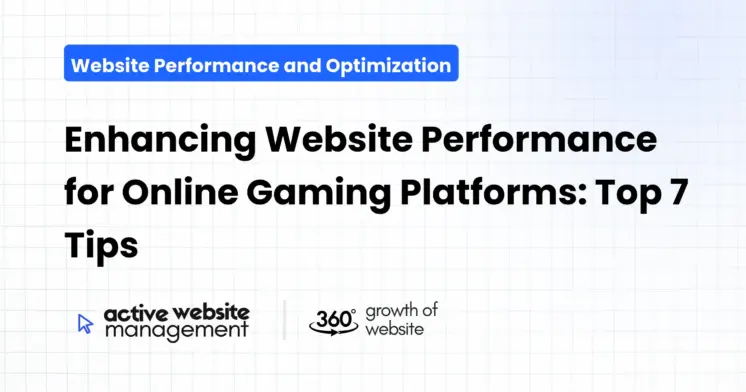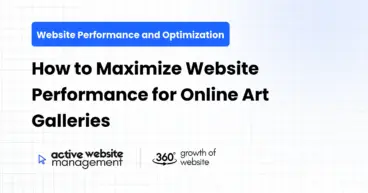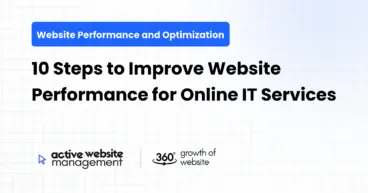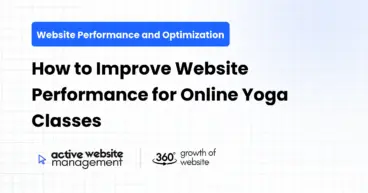February 3, 2025
18 min read
The thrill of online gaming hinges on seamless, immersive experiences. But what happens when lag creeps in, pages load at a snail’s pace, or the game stutters? Frustration, lost players, and ultimately, a blow to your online gaming platform. In today’s competitive digital landscape, optimizing your website’s performance is not just a nice-to-have; it’s a necessity for survival. This article delves into the core strategies for elevating your gaming site’s performance, ensuring that players keep coming back for more. We’ll cover everything from initial page load times to in-game interactions, focusing on practical steps you can take to make your platform a haven for lag-free, enjoyable gameplay. Get ready to unlock the full potential of your online gaming site!
1. Optimize Images: The Visual Feast Without the Weight
Images are the heart of any gaming platform. They showcase games, characters, and the immersive worlds that attract players. However, these visual elements are often the biggest culprits when it comes to website slowdowns. Imagine a beautifully crafted game screenshot taking ages to load—a recipe for immediate user frustration. Optimizing your images is paramount for a smooth gaming experience.
Why Optimize Images?
- Reduced Page Load Time: Smaller image files translate to faster page loads. Users won’t wait around for blurry images to come into focus.
- Lower Bandwidth Usage: Optimizing reduces bandwidth consumption, saving you money and benefiting users on slower connections.
- Improved SEO: Google and other search engines consider page load speed a critical ranking factor. Fast websites rank higher.
- Enhanced User Experience: A smooth, responsive website is more enjoyable to use, encouraging players to stay longer and play more.
How to Optimize Images: A Practical Guide
- Choose the Right Format:
- JPEG: Ideal for photographs and complex images. They offer excellent compression with minimal loss in quality.
- PNG: Perfect for graphics, logos, and images with transparency. While they have better quality than JPEGs, they result in larger file sizes.
- WebP: Google’s modern format provides superior compression and quality compared to JPEG and PNG. Best option, but might not be compatible with older browsers.
- Compress Your Images:
- Online Tools: Use websites like TinyPNG or Compressor.io to reduce file sizes without noticeable loss in quality. These tools strip unnecessary metadata and apply smart compression algorithms.
- Photoshop & other software: Use “Save for Web” options to adjust settings for optimal size reduction.
- Resize Images: Don’t upload huge images and let the browser resize them. Resize the image to the exact size it will be displayed on the website. This reduces unnecessary resource usage.
- Implement Lazy Loading: Load images only when they’re visible on the screen. This is especially useful on long pages with many images.
- Use CDNs (Content Delivery Networks): Store your images on a CDN. This distributes the content across various servers, speeding up downloads. CDNs serve content from a server closest to the user, reducing latency.
Don’t Just Maintain Your Website—
Grow It using Active Website Management! Don't Wait for Growth—Accelerate It with Active Website Management
Examples and Actions
- Before: A 2MB JPEG screenshot takes 5 seconds to load.
- After: A compressed 300KB WebP version of the same screenshot loads in under a second, boosting the user’s experience and page performance.
- Action: Audit all images on your gaming platform. Compress and resize each to a suitable level. Implement lazy loading on your gaming platform blog posts or other image-heavy pages.
2. Leverage Caching: Speeding Up Repeat Visits
Caching is your secret weapon for serving up your website faster. It’s all about remembering things users have seen before, so your site doesn’t have to reload everything from scratch each time they visit. This is especially crucial for online gaming platforms where repeat visits are common.
Understanding Caching: The Key to Speed
Caching works by storing static content, like images, CSS, JavaScript, and even entire web pages, in a temporary storage location. When a user requests this content again, the browser retrieves it from the cache, instead of making a new request to the server.
Types of Caching
- Browser Caching: The user’s web browser stores copies of static assets locally. This is why repeat visits to the same page tend to load significantly faster.
- Server Caching: Your web server stores copies of responses to requests, reducing server load and speeding up response times.
- CDN Caching: Content Delivery Networks cache content across a globally distributed network of servers, enabling faster downloads for users regardless of location.
Implementing Caching: How to Make it Work for You
- Leverage Browser Caching:
- Cache Control Headers: Set proper HTTP headers in your server configuration to control how long browsers should store cached resources.
- Enable Compression: Gzip or Brotli compress assets to reduce download size.
- Long Cache Times: Give static assets far-future expiration dates.
- Implement Server Caching:
- Caching Plugins: Use caching plugins if you are using CMS like WordPress or Joomla.
- Redis or Memcached: These in-memory data stores can cache query results or even entire web pages.
- CDN Caching: Use a reliable CDN like Cloudflare or AWS CloudFront to deliver cached content globally.
- Monitor Cache Hit Rates: Use performance monitoring tools to track the cache hit rate and identify any areas that need further optimization.
Benefits of Caching
- Faster Page Load Times: Cached pages load dramatically faster than pages that need to be generated from scratch.
- Reduced Server Load: Caching reduces the number of requests your server needs to handle, freeing up resources and reducing the risk of overload.
- Lower Bandwidth Consumption: Serving cached content means your server uses less bandwidth, saving on infrastructure costs.
- Improved SEO: Faster websites rank better in search results, attracting more organic traffic to your gaming platform.
- Better User Experience: Faster websites lead to a better, more engaging user experience, encouraging players to stay on your platform longer.
Examples and Actions
- Before: Without caching, every page request loads fresh data every time.
- After: With proper caching, static resources load from the browser’s cache, server cache, or a nearby CDN, significantly reducing page load times.
- Action: Review your server settings and update cache control headers. Enable browser caching and implement server-side caching with the help of caching plugins or Redis/Memcached. Begin using a CDN for static assets.
Your database is where all the crucial information resides: user profiles, game data, scores, and much more. A poorly optimized database can become a major bottleneck, resulting in slow queries and sluggish site performance. It’s like a clogged drain slowing down a whole house. Optimizing your database is critical for keeping your gaming platform running smoothly.
A database that’s not optimized will slow down the entire site. Every time a player views a game profile, checks their scores, or interacts with other players, your site relies on the database to retrieve the relevant data. Inefficient queries and slow database responses translate to a frustrating user experience with slow loading and lag.
Don't Wait for Growth—Accelerate It with
Active Website Management Don't Wait for Growth—Accelerate It with Active Website Management
Key Areas to Optimize
Database Design: Ensure that your database structure is optimized. Normalize your data to minimize redundancy, and create proper indexes for efficient querying.
- Normalization: Reduces data redundancy, improves data integrity, and makes your database more efficient.
- Indexes: Speed up data retrieval by allowing the database to quickly locate specific rows.
Optimized Queries: Writing efficient SQL queries is paramount to reducing database load and response time.
- *Avoid `SELECT
:** Always specify the columns you need to retrieve.SELECT *` can overwhelm the database and slow it down. - Proper Use of WHERE Clauses: Use indexes in your WHERE clauses to target specific rows.
- Limit the Number of JOIN Operations: Optimize and reduce the number of JOIN operations where possible.
- Batch Operations: When dealing with large datasets, perform operations in batches instead of one-by-one.
Database Server Configuration: Ensure your server is optimized with adequate memory, CPU, and storage capacity.
- Memory: Allocating sufficient memory can significantly speed up query execution by allowing more data to be stored in memory.
- CPU: Efficiently manage CPU usage. If the database is CPU-bound, it can slow down the performance of the entire platform.
- Storage: Use SSD for faster disk I/O.
Database Monitoring and Maintenance: Track database performance metrics and regularly maintain your database.
- Regular Backups: Ensure you have a solid backup plan.
- Performance Monitoring: Implement monitoring tools to track performance.
- Regular Maintenance: Regularly clear logs and optimize your database.
Practical Steps for Database Optimization
- Analyze Slow Queries: Identify the slowest-performing queries in your database by checking the database logs. This helps pinpoint the specific bottlenecks in your database.
- Add Indexes: Add indexes to frequently queried columns. Create composite indexes to optimize queries that filter by multiple columns.
- Rewrite inefficient queries: Rewrite your slowest queries by using specific columns, optimized conditions, and the right database functions.
- Optimize Database Configurations: Modify your database’s configuration settings. Allocate more memory, and tune buffer sizes to fit your workload.
- Regular Monitoring: Use database performance monitoring tools such as MySQL Performance Schema or SQL Server Profiler to keep track of query performance.
Examples and Actions
- Before: Inefficient SQL queries result in slow data retrieval, leading to noticeable lag on the site.
- After: Optimized database design, efficient queries, and proper configuration lead to quicker response times, improving site performance.
- Action: Conduct a database audit to check for slow queries. Index the correct columns. Write optimized queries and allocate suitable memory and storage capacity.
4. Minimize HTTP Requests: Less is More
Each component of a web page, from images and stylesheets to scripts, requires an HTTP request to the server. Multiple requests can add up, causing delays and slowing down the user experience. Reducing HTTP requests is an essential part of optimizing performance for a fast and responsive gaming platform.
What are HTTP Requests?
Every time a user visits a website, their browser sends a request to the server for various resources. The server responds with the content, which is then rendered in the browser. The more requests a website makes, the slower it becomes.
How to Reduce HTTP Requests
- Combine CSS and JavaScript Files: Merge multiple CSS files into one, and do the same for your JavaScript files. This reduces the number of requests the browser needs to make to load your platform.
- CSS Sprites: Consolidate small background images into a single file and use CSS to display the required sections. This reduces the number of HTTP requests for multiple small images, such as icons or buttons.
- Inline Critical CSS: Include the CSS needed to render above-the-fold content directly in the HTML. This can make your site render faster. This eliminates a separate CSS request for the initial view, leading to perceived speed improvements.
- Minimize Third-Party Scripts: Reduce or remove any unnecessary third-party scripts. Each third-party script adds an additional HTTP request and slows down performance. Evaluate if third-party scripts add much value to the user experience.
- Lazy Loading: As mentioned in image optimization, loading resources on demand can reduce the number of initial requests for content that is not immediately visible on the user’s screen.
- Use CDNs: Distribute your static assets, such as stylesheets, JavaScript files, and images, through a CDN. This reduces the load on your main server, thus speeding up response times.
The Impact of Reduced Requests
- Faster Load Times: Fewer HTTP requests translate to faster page load times, improving the overall user experience.
- Reduced Server Load: Reducing the number of requests eases the burden on your servers, leading to greater stability and cost-effectiveness.
- Improved Resource Utilization: Optimized page performance uses resources more efficiently, allowing your platform to handle more users simultaneously.
Examples and Actions
- Before: A page with multiple CSS and JavaScript files and a lot of small images makes numerous HTTP requests, causing slow load times.
- After: Merging CSS and JavaScript, using CSS sprites, and inlining critical CSS, reduces requests and drastically improves page load times.
- Action: Use developer tools to analyze the HTTP requests being made. Begin merging your CSS and JavaScript, and make use of CSS sprites.
5. Minify CSS and JavaScript: Streamline Your Code
Minification is the process of removing all unnecessary characters from your code without altering its functionality. This includes spaces, line breaks, comments, and other unnecessary elements. Minifying your CSS and JavaScript files can significantly reduce their file sizes, resulting in quicker downloads and improved website performance.
Why Minify?
- Reduced File Sizes: Minification drastically reduces the size of your CSS and JavaScript files, which translates to faster download times.
- Faster Page Load: Smaller files lead to faster page loading because browsers take less time to download and parse them.
- Improved User Experience: A fast-loading site provides a smoother experience, making users more likely to stay on your platform.
- Lower Bandwidth Consumption: Smaller file sizes require less bandwidth, saving on infrastructure costs.
How to Minify CSS and JavaScript
- Online Minifiers: Use free online minifiers such as CSSMinifier.com or Minifier.org. Copy and paste your CSS and JavaScript code, and they will generate minified versions for you.
- Build Tools: If you use a build process, set it up to automatically minify your files during the build. Task runners and bundlers like Webpack, Gulp, and Grunt offer plugins for this.
- CMS Plugins: Many content management systems (CMS) have plugins designed to minify CSS and JavaScript files. WordPress plugins, like Autoptimize or WP Rocket, automate this process.
- Server-Side Minification: Configure your web server to compress and minify responses on-the-fly using tools like mod_deflate for Apache or Brotli for Nginx.
Best Practices
- Automate Minification: Integrate minification into your development workflow so that you don’t forget to minify each time you update your code.
- Use Source Maps: When debugging your website in a browser, source maps can map the minified code back to the original code, making debugging easier.
- Test Thoroughly: Always check minified files to ensure no breaking changes have been introduced in the minification process.
- Combine Minification with Compression: Use gzip or Brotli compression alongside minification for maximum optimization.
Examples and Actions
- Before: Non-minified CSS and JavaScript files have unnecessary spaces and line breaks, resulting in larger file sizes.
- After: Minified files have all unnecessary characters removed, resulting in significantly smaller file sizes and faster loading times.
- Action: Use build tools or plugins to minify your CSS and JavaScript files. Make sure to integrate minification into your workflow.
6. Optimize for Mobile: A Mobile-First Approach
In today’s gaming landscape, a significant portion of users access online platforms through mobile devices. Optimizing your gaming platform for mobile is no longer optional; it’s essential. Mobile users have different needs and expectations than desktop users, so your gaming platform should cater to these unique requirements.
Why Optimize for Mobile?
- Increased Reach: Many players use mobile devices to access gaming content. A mobile-optimized site allows you to reach a wider audience.
- Improved User Experience: A site optimized for mobile devices will load faster and have a responsive layout, making it easier and more enjoyable for mobile users to navigate.
- SEO Benefits: Google uses mobile-first indexing, meaning it primarily uses the mobile version of a site for indexing and ranking.
- Higher Engagement: A mobile-friendly website that loads quickly and offers a smooth experience, encourages players to stay and explore your gaming platform for longer.
Strategies for Mobile Optimization
- Responsive Design: Implement a responsive design approach so your website adjusts to various screen sizes and orientations.
- Flexible Grids: Use CSS frameworks that implement flexible grids, allowing your content to adapt to the screen size.
- Media Queries: Use media queries to change the style of your elements based on device characteristics such as screen width.
- Touch-Friendly Interface: Ensure your interface is designed for touch screens. Buttons and interactive elements should be large enough and far enough apart so that they are easy to tap on.
- Mobile-Specific Performance Optimization:
- Prioritize Content: Load critical content, such as text and above-the-fold elements first.
- Optimize Images: Serve scaled-down or lower-resolution images for mobile devices.
- Simplify Navigation: Make navigation easy and intuitive for small screens.
- Use Accelerated Mobile Pages (AMP): Consider implementing AMP for content-heavy pages like blog posts.
- Test on Various Mobile Devices: Regularly test your website on various mobile devices and browsers to ensure it’s functioning correctly and displays properly.
Benefits of Mobile Optimization
- Faster Loading Times: A mobile-optimized site loads quickly, which is especially important on mobile networks.
- Better User Experience: An easy-to-use interface makes users more engaged.
- Improved SEO: A mobile-friendly site boosts your SEO rankings.
- Increased Traffic: Mobile optimization leads to more mobile users visiting and interacting with your gaming site.
Examples and Actions
- Before: A desktop-focused site loads slowly and displays poorly on mobile devices, resulting in poor user experience.
- After: A mobile-optimized platform has a responsive design, loads quickly on mobile devices, and has a touch-friendly design.
- Action: Start with a mobile-first approach. Review your website’s layout, design, and loading times from the perspective of a mobile user. Make adjustments accordingly.
7. Active Website Management: Continuous Improvement and Optimization
Optimizing your online gaming platform isn’t a one-time effort; it’s an ongoing process. Active website management involves continuous monitoring, testing, and implementing changes to keep your platform performing at its best. It is about ensuring your platform is not only working great today but will continue to excel in the future as well.
Why Active Management is Crucial
- Adapting to Changes: The web landscape is constantly evolving, with new technologies and user expectations arising frequently. Active management lets you adapt to these changes.
- Identifying and Resolving Issues: Monitoring your platform helps you identify performance issues or bugs early, allowing for quick fixes that avoid disrupting users.
- Keeping Up with User Needs: Analyzing user behavior lets you understand what works and what doesn’t. This helps you make informed decisions about improvements.
- Maintaining a Competitive Edge: Consistently working on optimization keeps your website ahead of the competition.
Key Elements of Active Website Management
- Performance Monitoring:
- Tools: Use tools like Google PageSpeed Insights, GTmetrix, and WebPageTest to monitor page load times, identify performance bottlenecks, and track performance metrics.
- Regular Audits: Conduct regular performance audits to find new issues and ensure all parts of your site are still optimized.
- User Behavior Analysis:
- Analytics Tools: Use Google Analytics to track user behavior, understand how users interact with your site, and identify areas where users drop off.
- Heatmaps and Session Recordings: Use tools like Hotjar to understand user interactions visually, and observe user behavior on your website.
- A/B Testing:
- Experimentation: Conduct A/B tests to compare different versions of a page or element. Check what resonates the most with your audience.
- Data-Driven Decisions: Base all changes on data and evidence from the A/B testing results.
- Content Updates:
- Fresh Content: Regularly update your content to keep it relevant and interesting for your users.
- Performance-Focused Content: Optimize content for performance, ensuring that text, images, and multimedia load quickly and efficiently.
- Security Updates:
- Regular Updates: Keep your website’s platform, themes, and plugins up to date to patch any security vulnerabilities.
- Security Audits: Perform regular security audits to proactively identify and resolve security flaws.
The Benefits of Active Website Management
- Optimal Performance: Regular monitoring and optimization ensure your site runs at peak performance.
- Enhanced User Experience: A fast, reliable, and up-to-date platform provides a great experience for users.
- Increased Engagement: An engaging platform will encourage users to return to your gaming platform.
- Higher Conversion Rates: Improved performance often translates into higher player retention.
- Better ROI: A platform that works efficiently and is maintained properly will lead to better return on your investment.
Examples and Actions
- Before: A once-optimized website suffers from decreased performance due to lack of ongoing management.
- After: Active website management results in a continuously optimized and up-to-date website.
- Action: Set up performance monitoring tools. Regularly check user analytics data, conduct A/B tests, and perform routine audits of your website.
For those seeking a dedicated partner in ensuring their gaming platforms are optimized and managed effectively, consider exploring services from Active Website Management . Their expertise in managing websites can alleviate the burden of routine optimization, allowing you to focus on other critical aspects of your gaming platform.
Conclusion
Optimizing your online gaming platform for performance is a continuous journey, but it’s essential for success in the competitive gaming industry. By implementing the top 7 tips in this article—optimizing images, leveraging caching, optimizing the database, minimizing HTTP requests, minifying CSS and JavaScript, optimizing for mobile, and embracing active website management—you can create a fast, responsive, and engaging experience for your players. Remember, every millisecond counts in the world of online gaming. By prioritizing performance, you’ll create a gaming platform that not only attracts players but also keeps them coming back for more. This will ultimately result in higher player engagement, better conversions, and a much more successful online gaming experience for all.







